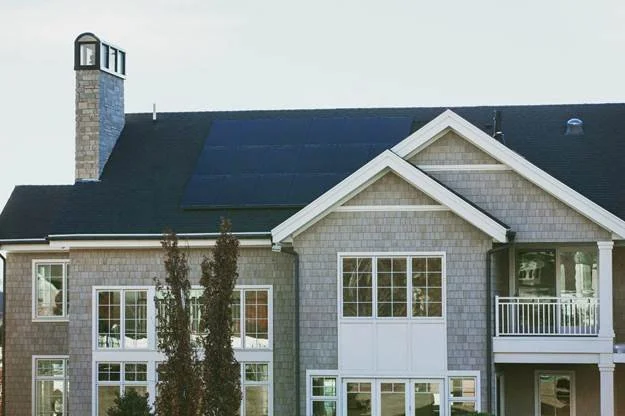Is Your New Roof Installed Correctly? A Homeowner's Guide to Workmanship Quality
You did it. You researched contractors, chose the materials, signed the contract, and wrote a check that could have bought a decent car. The crew has packed up, the last shingle is in place, and from the curb, everything looks... new.
But now, a quiet anxiety starts to creep in. How do you really know if the job was done right? You're not a roofer. You can't tell a properly driven nail from a future leak waiting to happen. And you've heard the horror stories.
Honestly, that feeling is completely justified.
Here's a number that keeps roofing professionals up at night: up to 60% of all premature roof failures are caused by poor installation, not faulty materials. Think about that. The beautiful, 30-year architectural shingles you paid a premium for could fail in 10-15 years, all because of mistakes made during the installation process.
That's a catastrophic failure of value, and it's what drives the fear every homeowner feels after a major renovation. You've made a huge investment to protect your home, your family, and your peace of mind. Now you need the confidence to know it was done right.
This guide is your solution. We're not just going to give you a flimsy checklist. We're going to walk you through the four critical layers of a quality roof installation—from the quick visual cues you can spot from your driveway to the technical details that separate the pros from the pretenders. This is the same framework we use to evaluate our own work, and it's what you should expect from any contractor you hire.
Table of Contents
• Key Takeaways: Your Quick Reference Guide
• Part 1: The 10-Point Curb Appeal Check (What You Can See from the Ground)
• Part 2: The Technical Deep Dive (A Closer Look at Your Roof Type)
• For Flat & Low-Slope Roofs (TPO)
• Part 3: The Flashing Fail-Safe (The #1 Source of Leaks)
• Part 4: The Accountability Framework (Your Final Payment Checklist)
• How to Talk to Your Contractor About Workmanship Concerns
• The Creative Roof Solutions Promise
Key Takeaways: Your Quick Reference Guide
• Workmanship is King: Up to 60% of roof failures stem from installation errors. The quality of the labor is more important than the cost of the materials. • Look for Uniformity: From the ground, your roof should look clean, straight, and uniform. Shingle lines should be perfectly horizontal, and there should be no visible sagging. • Material-Specific Details Matter: A quality shingle installation focuses on nail placement. For metal, it's about fastener tension and panel handling. For flat roofs, it's all about watertight seams and proper drainage. • Flashing is Everything: The #1 cause of leaks is improperly installed flashing around chimneys, vents, and valleys. It must be woven into the shingles, not just sealed with caulk. • Don't Release Final Payment Blindly: Before you sign the last check, ensure you have your warranty paperwork, proof of a passed final inspection, and confirmation that the site is clean of all debris, especially nails.
Part 1: The 10-Point Curb Appeal Check (What You Can See from the Ground)
You don't need to climb a ladder to get a first impression of workmanship quality. A quick walk around your property can reveal a lot about the crew's attention to detail.
Uniform Appearance: Does the roof look consistent? There shouldn't be mismatched shingle colors or obvious patches. The overall aesthetic should be clean and cohesive.
Straight Shingle Lines: Look at the horizontal lines created by the bottom edge of the shingles. They should be perfectly straight across the entire roof. Wavy or uneven lines are a red flag for rushed work.
No "Fish Mouths": Are any shingle tabs curling up or lifting? These gaps, called "fish mouths," catch wind and water and are a clear sign of installation error.
Clean Drip Edge: The metal edge along the eaves and rakes of your roof (the drip edge) should be clean, straight, and installed under the roofing felt at the eaves and over it on the rakes. It's a small detail that makes a huge difference in water management.
No Sagging: Look at the ridgeline and the planes of the roof. Do you see any dips, bows, or sagging spots? This could indicate underlying structural issues that should have been addressed before the new roof was installed.
Pristine Gutters: Your gutters should be completely clear of debris, shingle granules, and packaging. A professional crew cleans the gutters as part of the job.
Undamaged Siding & Landscaping: Check your siding, windows, and landscaping for dents, scratches, or damage. A careful crew protects your property.
No Exposed Fasteners: You really shouldn't see nails or screws on the face of the shingles. Fasteners should be covered by the course of shingles above them.
Magnetic Sweep Confirmation: Ask your contractor if they did a magnetic sweep of your yard, driveway, and garden beds. A single leftover nail can mean a flat tire or an injury.
Overall Cleanliness: Does the property look as clean or cleaner than when they started? This speaks volumes about the crew's professionalism.
[image: A perfectly aligned asphalt shingle roof in the Pacific Northwest sunlight, showing clean lines and no visible flaws. alt="A close-up of a perfectly installed asphalt shingle roof, highlighting the quality of Creative Roof Solutions' workmanship."]
Part 2: The Technical Deep Dive (A Closer Look at Your Roof Type)
This is where the real evaluation happens. While the points above are important, the long-term health of your roof depends on technical details specific to the material you chose. Here's what to look for.
For Asphalt Shingle Roofs
Asphalt shingles are the most common residential roofing material in the Pacific Northwest, but they are also the most frequently installed incorrectly.
• Proper Nailing: This is, without a doubt, the most critical factor. Every shingle has a designated "nailing strip." • Placement: Nails must be placed within this strip. Too high, and the shingle can be lifted by the wind. Too low, and the nail head will be exposed. • Depth: Nails should be driven flush with the shingle surface. Over-driven nails break through the shingle's matting, voiding the warranty. Under-driven nails can work their way up over time, creating a leak point. • Starter Strip Installation: A specific row of adhesive shingles, called a starter strip, must be installed at all eaves and rakes. It's the first line of defense against wind uplift. Skipping this step or using a cut-up shingle instead is a common, and costly, shortcut. • Staggered Seams: The vertical seams between shingles should never line up in consecutive rows. They should be properly staggered (offset) to ensure water can't find a direct path to the underlayment. • Valley Construction: In the valleys where two roof planes meet, proper installation is non-negotiable. Woven valleys or those using a solid metal flashing are both acceptable methods, but simply caulking the seam is not.
For Metal Roofs
Metal roofing is a premium product, and it demands precision. The mistakes here are often less obvious but can be just as damaging.
[image: A sleek, modern standing seam metal roof on a home in King County, showcasing straight panels and clean edges. alt="A modern home with a high-quality standing seam metal roof installed by Creative Roof Solutions."]
Understanding "Oil Canning": This refers to the visible waviness or distortion in the flat area of metal panels. It's important to know that a minor amount of oil canning is an inherent characteristic of light-gauge metal and not necessarily an installation flaw. However, excessive oil canning can be caused by over-tightening fasteners, which puts stress on the panel. • Correct Fastener Torque: For exposed fastener systems, screws must be driven to the correct torque. Too tight, and it will damage the rubber washer and cause oil canning. Too loose, and it won't create a watertight seal. A pro knows the exact feel of a perfectly seated screw. • Clean Cuts & Scratches: Metal panels must be cut with shears, not a grinder. Grinders throw hot metal particles that damage the panel's protective coating, leading to premature rust. Check for deep scratches or gouges from mishandling, which can also compromise the finish and lead to corrosion. • No Dissimilar Metals: A knowledgeable installer knows that you can't let certain metals touch. For example, allowing copper runoff to flow over a galvanized steel (Galvalume) roof will cause rapid corrosion. All flashing and fasteners must be compatible with the panel material.
For Flat & Low-Slope Roofs (TPO)
Flat roofs, common on modern homes and additions, require a completely different skill set. The margin for error is virtually zero.
[image: A roofer using a heat welder on a TPO flat roof seam, demonstrating a critical step in ensuring a waterproof seal. alt="A professional roofer heat-welding a TPO flat roof seam."]
• Watertight Seams: For TPO or PVC membranes, the seams are everything. They should be heat-welded together to form one continuous, waterproof sheet. You can check a seam by trying to gently pick at the edge with your fingernail. A good weld is impossible to separate. There should be no "cold welds" that can be easily pulled apart. • Code-Compliant Slope: Here's a crucial point many homeowners miss. Per building codes, even a "flat" roof must have a minimum slope—typically 1/4 inch of fall for every 12 inches of run. This is essential to prevent "ponding," where water sits for more than 48 hours, which can void warranties and eventually lead to leaks. • Proper Flashing at Penetrations: Any pipes, vents, or skylights coming through the roof are weak points. The membrane should run up the side of these penetrations and be properly flashed and sealed. There should be no signs of stretching or tenting of the membrane around these areas.
Part 3: The Flashing Fail-Safe (The #1 Source of Leaks)
If you take one thing away from this guide, let it be this: flashing is the most important part of your roof system. It's the metalwork that directs water away from the most vulnerable areas: chimneys, skylights, dormers, vents, and valleys.
Caulk and roof cement are not flashing. They are temporary seals that will fail under the Pacific Northwest's relentless sun and rain. Proper flashing involves layers of metal that are integrated with the roofing material.
[image: A diagram comparing a properly installed step flashing (layered correctly) versus an improperly installed one (exposed fasteners, gaps). alt="Diagram showing the right and wrong way to install roof step flashing."]
• Step Flashing: Along walls that meet the roof, you should see individual pieces of L-shaped metal woven into each course of shingles. You shouldn't see one long, continuous piece of flashing running along the wall (this is a common shortcut). Counter-Flashing: For chimneys and brick walls, there should be a second layer of flashing (counter-flashing) that is cut into the mortar joint and folded down over the step-flashing. This creates a two-part system that ensures no water can get behind the primary flashing. • Valley Flashing: As mentioned before, valleys need robust protection. A wide metal "W" valley flashing installed beneath the shingles is the gold standard, providing two channels for water to run off.
A contractor who rushes the flashing is a contractor who is setting you up for a future leak. Period.
Part 4: The Accountability Framework (Your Final Payment Checklist)
You hold the power until the final check is written. Before you sign off, use this checklist to ensure the job is truly complete and your investment is protected.
• [ ] Warranty Documentation in Hand: You need two warranties: one from the material manufacturer (e.g., Owens Corning) and one from the contractor for the workmanship. Make sure you have the physical or digital copies and understand the terms. • [ ] Proof of Final Inspection: If your project required a permit, the contractor should provide you with proof that it passed the final inspection from your local building department. Do not release payment without this. • [ ] Lien Waivers: A lien waiver is a document from the contractor, and potentially their suppliers or subcontractors, stating they have been paid in full and waive their right to place a lien on your property. This protects you from disputes you weren't a part of. • [ ] All Debris is Removed: This includes the magnetic sweep for nails and a final check of the gutters. • [ ] You've Done Your Walk-Through: Walk the property with the project manager and go through the points in this guide. Ask questions and point out anything that concerns you.
How to Talk to Your Contractor About Workmanship Concerns
It can be intimidating to question a professional. But a true professional will welcome your questions and be happy to explain their process. Here's how to approach it without being confrontational:
• Frame it with curiosity: "I was reading about the importance of the starter strip, and I'm just curious to understand how it works. Could you show me where it was installed here?" • Use "we" and "us": "Could we take a quick look at the flashing around the chimney together? I want to make sure I understand how it's protecting the house." • Refer to the contract: "I just want to double-check the cleanup process we agreed on in the contract. Does that include a magnetic sweep of the yard?"
A good contractor will be proud to show off their quality work. A contractor who gets defensive or dismissive is waving a major red flag.
Frequently Asked Questions
What if my roof has already passed the city inspection? Does that guarantee quality? Not necessarily. A city inspection is primarily for code compliance and safety—it's a check for major, obvious errors. It is not a detailed workmanship quality audit. A roof can pass inspection and still have flaws that lead to a shorter lifespan.
Is a little bit of unevenness in the shingles normal? On an older home where the underlying roof deck may have settled, some minor waviness might be unavoidable. However, on a straight and solid roof deck, the shingle lines should be exceptionally straight.
I see a lot of granules from the shingles in my gutters. Is that bad? It's normal to see some loose granules immediately after installation—this is just excess from the manufacturing process. If you continue to see significant granule loss months later, it could indicate a problem.
How long do I have to report a problem? This is where your workmanship warranty is critical. Most reputable contractors offer a warranty of at least 5-10 years, and some even longer. However, it's always best to identify and address issues immediately after the job is completed.
The Creative Roof Solutions Promise
We know this is a lot to take in. As a family-owned company founded by a father and son with over 30 years of combined experience, we've built our reputation on getting these details right the first time. Our background in public safety instilled in us a core belief in honesty, safety, and clear communication—values that are, frankly, sometimes missing in this industry.
We don't just sell roofs; we provide lasting protection for families in our Snohomish, Skagit, and King County communities. We treat every installation as if it were on our own home, which is why we're an A-rated, BBB-accredited business and a preferred installer for Owens Corning. You can see the pride we take in our craftsmanship by looking at our work.
Whether we installed your roof or not, we believe every homeowner deserves peace of mind. If you're looking at a new roof and feeling that nagging anxiety, or if you're planning a project and want to ensure it's done to the highest standard, we're here to help.
Get a free estimate and let us show you what true roofing quality looks like. We can also discuss how our solar panel installations can integrate seamlessly with a high-performance roof, further protecting your investment for decades to come.




